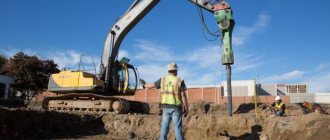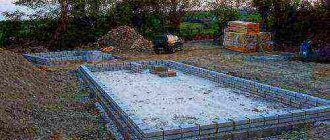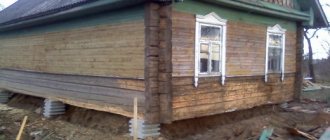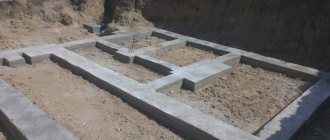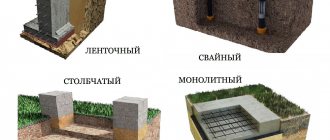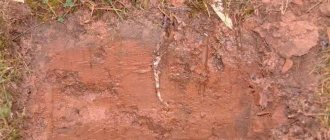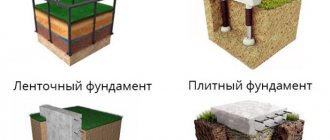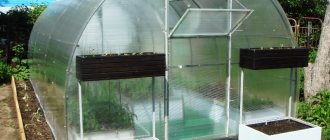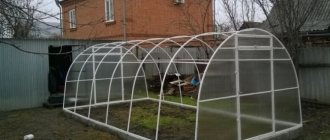If the soil on the site where you are going to build a house turns out to be sandy, consider yourself lucky. Such soil is better than clayey and especially peaty. The bearing capacity of such soil is quite high, especially if the sand is coarse. Sand permeates water well, so it is little susceptible to frost heaving, except for the smallest sand. How to make a foundation on sandy soil, what problems may arise and what should you keep in mind?
Types of sandy soil
Sandy soils, depending on the size of the sand grains, are divided into the following types, differing in their bearing capacity:
- gravelly - more than 25% of sand grains larger than 2 mm,
- large - more than half of the sand grains are larger than 0.5 mm,
- medium - more than half of the grains of sand larger than 0.25 mm,
- small - grains of sand larger than 0.1 mm more than 3/4,
- silty - grains of sand larger than 0.1 mm less than 3/4.
Pros and cons of sandy soil
Sandy soil is not so bad - it is considered the second most reliable after rock. Of course, its properties depend on the size of the sand grains.
Coarse gravelly sand has excellent load-bearing capacity, does not heave, and any foundation can be made on it. Fine sand absorbs water and therefore has the property of heaving, especially very fine, dusty sand. Also, when fine and dusty sand absorbs water, its load-bearing capacity decreases.
Important! Before starting construction, it is necessary to conduct geodetic surveys to find out what kind of soil you have on the site. Sandy soil is often heterogeneous; coarse sand may be on top and fine sand or clay below.
Sandy soil does not hold water well, so when building a house on sand, special attention should be paid to waterproofing and thermal insulation of the foundation.
Most often, a strip concrete foundation is made for a house on sandy soil. It is not suitable for highly mobile soil, but for dusty sand it is the best option. Pile or pile-tape is also suitable, especially on quicksand. The most reliable base option is a slab, but this is also the most expensive option. The slab requires a lot of concrete and reinforcement. It is suitable for small but massive buildings.
Materials for creating a pillow
Even judging by the name, a “sand pillow” is made from sand, but not just any sand, as it might seem, but coarse-grained sand.
The ideal option is coarse gravelly sand. It is “coarse” sand or medium-fraction river sand that will resist possible shrinkage of the structure.
But many experts recommend using a sand-gravel mixture to create a layer, citing better drainage and compensation properties.
In fact, for the compensation layer you can use any less heaving material that resists compression well.
It is much more important to protect this layer from the influence of moisture during seasonal increases in groundwater levels. To do this, you need to prevent the soil from mixing with the sand cushion by laying a layer of geotextile between them.
Foundation on coarse sand
On large sandy soils, any foundation can be made. Most often, a columnar or strip foundation is used, which can be built from foundation blocks or ceramic bricks. For a house without a basement, a shallow-type strip foundation is made. You can also choose a columnar base - it is suitable if the house is built from lightweight materials (wooden, panel, frame).
Strip foundation
The depth of a shallow-type strip foundation is 50-70 cm. On such a foundation you can put a wooden, frame, panel or small brick house, as well as a building made of foam blocks. Strip foundations on coarse sand can be either monolithic or prefabricated.
For massive buildings and houses with a basement or residential basement, the strip foundation is made deep. For a brick house, the base of the foundation must be at least 20 cm below the soil freezing level. When installing a recessed strip foundation, be sure to waterproof it on all sides, including from below, and also provide complete drainage. High-quality waterproofing will allow you to build a house with a basement even with high groundwater.
You can fill a monolithic shallow tape with your own hands as follows:
- First, the site needs to be prepared: remove a layer of fertile soil, level it, mark it. To mark, you need to have a plan or project of the house.
- Then they dig a trench 60-80 cm deep and a width equal to the thickness of the future walls plus 20 cm: 5 cm on each side for stability and another 5 cm for formwork.
- The formwork is made from corrugated sheets, plywood, edged boards, and the inside is lined with polyethylene.
- For shallow tape, reinforcement plays a vital role. The correct reinforcement is described in the video below.
- Then concrete is poured into the formwork.
Determining soil type
When creating a plan for the construction of a foundation, it is a good idea to analyze the properties of the soil from an engineering-geological point of view. To determine the type of soil from a site, sand is taken, clay and silt are examined as a percentage or by the tactile-visual method. The analysis is performed independently or with professionals. Geological surveying involves drilling deep wells from which samples of soil and groundwater are taken to be analyzed in a laboratory. Geodetic survey does not allow serious errors to occur. By fixing them, you can spend much more money than on building a foundation for a house.
Drainage
Drainage is especially important for buildings on shallow sandy soil. The most effective are closed drainage systems, where drainage pipes play a major role. To make such a pipe with your own hands, take an ordinary plastic sewer pipe and drill holes in it. The pipes are wrapped in geotextiles and laid in trenches dug around the house. Be sure to make outlets to the surface, which are covered with gravel and covered with geotextiles and turf. The drainage arrangement is shown in the figure.
Foundation on fine sand
For building a house on fine, dusty sand, the best option would be a monolithic strip shallow foundation. To reduce the effect of frost heaving of the soil on the base of the building, it is better to make it trapezoidal (expanding downwards). The advantage of a strip foundation is its small impact on soil erosion.
Important! Before pouring the foundation, the trench must be waterproofed using a special film.
For a heavy building, a pile or pile-tape option is better suited. In some cases, when the soil is very weak, it is advisable to make the base on a sand bed made of coarse sand. The video describes the features of the foundation on pulverized sand.
Pile-strip foundation
This type of base is suitable for weak soil with the possibility of the formation of quicksand (fine sand saturated with water, which liquefies when exposed to it). To install such foundations, markings are made on the site and a pit is dug. Formwork is installed in it. Then, at the intersections of the foundation strip, wells are drilled to such a depth that they reach more reliable soil.
Asbestos-cement pipes are lowered into the wells, leveled and reinforced with spacers. Then the solution is poured into the pipes to a third of the depth, and the pipe is lifted so that a thickening forms at the bottom. After this, the fittings are lowered into the pipe and filled with solution to the end. The reinforcement should protrude so much that it can be connected to the reinforcement of the foundation strip.
If the soil is not very wet and the well is not filled with water, the piles can be filled in another way, without the use of pipes. After drilling wells, their lower part is expanded using a special plow, and then reinforcement is lowered into the wells and filled with concrete. After the piles harden, the foundation strip is poured into the formwork. This method is suitable not only for fine sand, but also for other complex and heaving soil.
To get a stronger foundation, keep the following in mind:
- It is highly advisable to fill it at a time or in layers, so that vertical seams do not occur, reducing strength.
- You should not weld parts of the reinforcement - corrosion will begin faster at the seams.
Important! Before continuing work after pouring, the foundation on fine sand must stand for at least 6 months.
The video describes the process of constructing a pile-tape foundation:
Pile foundation
You can build a pile foundation for a house on shallow sandy soil. It is very durable and stable, since the piles are installed below the freezing level of the ground. It is more reliable than a columnar one, which, under the influence of soil heaving, can begin to warp and move apart. A pile-screw foundation can be installed on quicksand, since the piles go deeper below its level and rest on harder soil.
Piles may be
- screw,
- printed,
- bored.
Slab foundation
This type of foundation is called floating, since it moves with the soil and is therefore practically not subject to destruction due to heaving. It is very durable and reliable, but at the same time expensive due to the high consumption of material. It is suitable for moving soils, such as on a hillside. When the soil moves, the house on the slab “floats” with it and is not damaged.
Excavation
Scheme of a monolithic slab foundation.
Pits (trenches) are usually dug with an excavator. Their shape depends on the type of soil and its depth.
The depth of the trench without formwork is calculated as follows:
- up to 1 m for trenches with vertical, even walls on sandy and gravel bases;
- up to 1.25 m for trenches with vertical smooth walls on sandy loam;
- up to 1.5 m for trenches with vertical smooth walls on loams and clays.
When laying columnar foundations, pits are dug in a round or square shape. Round-shaped pits are resistant to the collapse of soil walls.
Pits and trenches must be isolated from surface water runoff. If water from the site flows into the trenches, the base liquefies and loses its load-bearing capacity. To drain surface water, ditches and dumps are made.
To prevent the slopes of the trench from collapsing and the base from becoming soggy from precipitation, you need to lay the foundation immediately.
If you decide to lay the foundation of a house not immediately, but after a certain time, it is better not to dig the trench completely to the design values of 10-15 cm. Undug soil will protect the trench from soaking the foundation during precipitation. Already before laying the foundation, the earth is removed to the required levels.
In no case is it allowed to add excavated earth to places where it was accidentally thrown back into the trench. Due to its filling, uneven shrinkage of the foundation may occur and the house may simply burst.
Sand, crushed stone, and gravel can be poured into places where soil is accidentally picked up. Then they need to be well compacted. The best option is to fill the overflow areas with concrete.
